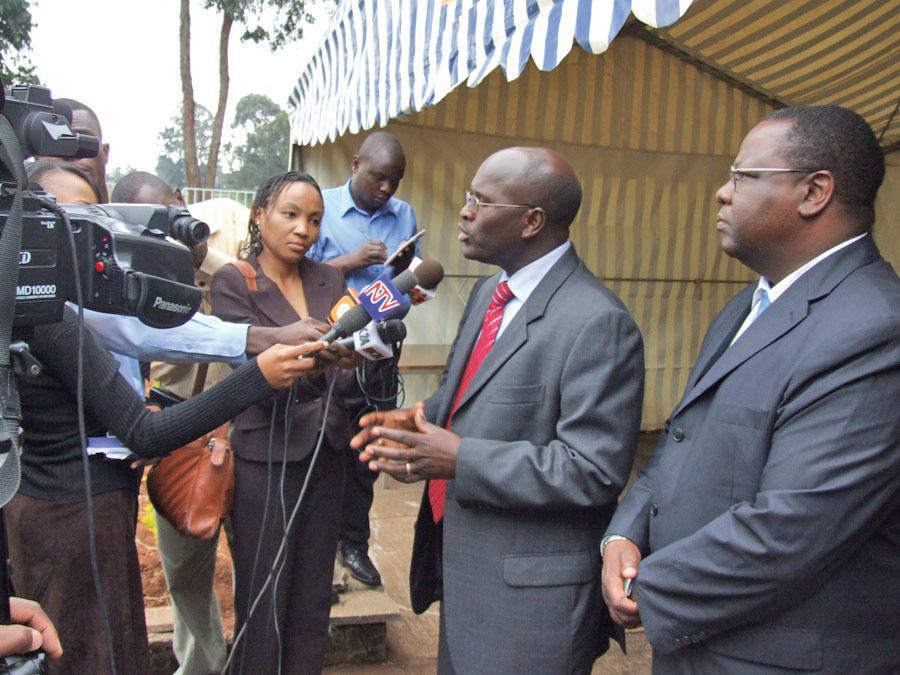
14 minute read
In search of clean source of power
In search of clean sources of power
By Wamaitha Omondi
Advertisement
Kenya has not been spared the effects of the skyrocketing prices of oil. There has been an enormous increase in the prices of food and other basic needs.
Under Vision 2030, however, the country has set a growth target of 10 percent per annum over the next 20 odd years and achieving this target, according to the experts, will strongly depend on reliable and affordable energy supply for various activities.
A new programme was recently unveiled to promote Kenya’s renewable energy sources, while conserving non-renewable energy sources.
The blueprint dubbed ‘Kenya Energy Sector Environment Programme (KEEP)’ aims at transforming the Kenyan economy into a world-class economy through energy efficiency, environmental conservation and restoration.
Energy Minister, Kiraitu Murungi points out that the initiative was an action plan by both the government and its parastatals to conserve the environment.
Under the slogan ‘Kawi,Uchumi na Mazingira Bora’ the programme aspires to create visible projects with high impact and sustainable social-economic benefits through value adding partners and it will be based on energy conservation, tree growing for environmental conservation and commercial purposes, water shed management, education and public awareness.
The minister says KEEP is critical in the conservation efforts as it will be instrumental in addressing the important energy sector while at the same time checking depletion of forest cover without impeding the supply of timber and other forest products.
“The long-term objective is to improve the livelihood of the Kenyan people through energy and environmental conservation on a sustainable basis. KEEP will specifically promote and popularize the benefits of environmental conservation and restoration. It will also strive to create a culture of efficient energy use by promoting energy efficient appliances and fittings where investors could invest in tree growing as it has been proven to be a commercially viable venture,” Murungi says.
Kenya Electricity Generating Company Ltd (Kengen), managing director, Eddy Njoroge, says that the ten year action plan will steer in mitigating the effects of climate change which is a global debate and one tough challenge of our recent times.
Njoroge adds that his company, which is operating within NEMA recommended guidelines, has taken a deliberate strategy to pursue renewable sources of power from its indigenous geothermal and hydro sources.
“About 85 percent of our planned new capacity will come from clean geothermal and hydro renewable sources. Pursuing these activities that conserve the environment will also bring additional benefits from carbon credit proceeds,” says the Kengen boss.
Kenya is a signatory to the Kyoto Protocol and therefore eligible to participate in clean development mechanism (CDM) carbon trading arrangements.
Launching the initiative recently, Prime Minister Raila Odinga said that energy by its nature affects all sectors of development and that neglecting its role as a resource and a factor of production can therefore impede the formulation and implementation of development policies and programmes.
The prime minister said: “Mount Kenya, Aberdare range, Cherangany Hills among other water towers are the lifeline of the nation. However, the destruction of more than 100,000 hectares of forest cover in the Mau catchment area is due to illegal encroachment and the total annual revenue loss arising from such destruction is huge. In addition, the Kenyan economy namely energy, agriculture, water, livestock and tourism are closely intertwined with the conservation of these water catchments. Their destruction will impoverish the future generation of Kenya and it is vitally important that we protect them now.”
Odinga noted that siltation is mainly attributed to, poor land use practices, deforeatation, sand harvesting and clearing of land for settlement in the water catchments which reduces the capacity of the dams to retain water and the reservoir’s ability to regulate flows during drought.
KEEP comes into being as part of the reform packages and policy intervention that will ultimately lead to accelerated economic growth and development.
“The government developed a policy direction, legal and regulatory framework which are instrumental in consolidating and ring-fencing the energy sector reforms and it also infuses new thinking into the energy sector that is aimed at setting a foundation for a vibrant, modern and forward looking sector,” the prime minister observed.
The use of a collaborative strategy in the implementation of KEEP will be useful in ensuring that the fruits of the programme trickle down the grassroots.
.
Primarily, KEEP aspires to improve livelihoods in line with national development goals to address poverty through activities such as tree growing for wood fuel as well as for commercial purposes.
Furthermore, it is important to instill environmental awareness and efficient energy utilization habits in the young generations so as to build an environmentally responsible generation
water, and creating waste at an alarming rate, even as new technology raises crop yields, conserves resources and cleans up pollution.
While rich nations with low population growth are mainly accountable for the unsustainable use of the planet’s resources, developing countries, with lower overall consumption contribute a growing share of total CO2 emissions. UNFPA argues that slowing the rate of population growth may give countries time to take measures to meet people’s needs, while protecting the environment through various means.
The agency further argues that preventing unwanted births through family planning, and guaranteeing individuals and couples the right to reproductive health, can help slow population growth rates and moderate environmental impact and it might be one of the most costeffective ways of doing so.
The world population is rising by 78 million people per year and is projected to grow from 6.7 billion people to 9.2 billion by 2050 over 3 times the population at the turn of the millennium. However, if birth rates remain unchanged, the U.N estimates that world population will be 11.9 billion by 2050.
UNFPA says that since the 1960s, fertility in developing countries has been reduced from an average of six births per woman to three, thanks primarily to the use of contraceptives. However, in 56 developing countries, the poorest women still average six births, compared to 3.2 for the wealthiest nations.
The wealthiest nations with less than 20 per cent of the earth’s population and the slowest population growth, accounts for 86 per cent of national resource consumption – much of it wasteful-and produce the majority of the pollution and CO2.
At the other extreme, the depletion of natural resources is occurring most rapidly in the poorest countries, where fertility rates are highest. The poorest 20 per cent of countries account for only 1.3 per cent of consumption; but their urgent drive for economic growth often leads to lax regulations of polluting industries and pressures to use marginal land for food.
Demand for water and food
Increased demand for water is directly related to population growth since more water is needed to grow more food. Lack of access to water is already putting pressure on about a third of the world’s population. Climate change is expected to make the problem worse in many places.
The challenges of preserving a sustainable environment is greatest in poor countries that already struggle to meet their people’s needs and that face the greatest population growth and, because large and poor families put pressure on the environment, the search for fuel, wood, water and other basic needs makes the poor unwitting agents of environmental change. In poor countries, most of these agents are women and children. UNFPA says one woman dies every minute from causes related to pregnancy and childbirth. Many of these women would still be alive if they had not had unintended pregnancies. That is why this year’s World Population Day adopted a family planning theme: “Promote and Invest in Family Planning for National Development.” Family planning refers to the use of modern contraception and other methods of birth control to regulate the number, timing and spacing of children.
According to Mr. Charles Zirarema, the Acting Director of Uganda’s Population Secretariat, there is no doubt that family planning has proven benefits in terms of gender equality, maternal health, child survival, and preventing HIV.
“Family planning can also reduce poverty and promote economic growth by improving family well-being, raising productivity and lowering fertility. It is hence one of the wisest and most cost-effective investments any country can make towards a better quality of life,” he says.
He argues that limited access to contraception, on the other hand, constrains women’s opportunities to pull themselves and their families out of poverty. With many maternal and child related deaths occurring across the country because of frequent unintended pregnancies, health and population experts are urging more investment in family planning services.
In Uganda, about 1.5 million women would like to delay pregnancy, space their children or stop child bearing altogether, but are not currently using any contraceptive method. As a result, Uganda’s total fertility rate of 6.7 children is among the highest in the world, yet the expected fertility rate is about five children for women, according to the 2006 Uganda Domestic and Health Survey.
Dr. Hassan Mohtashami, the UNFPA Country Representative for Uganda recently noted that family planning should go beyond fertility issues and instead put more emphasis on bringing women’s health, human rights and development into focus.
Speaking at a public debate at Hotel Royale in Kampala on the theme: “Family Planning for Uganda’s Development; Seizing a Missed Opportunity,” on July 3, Mohtashami said when there is knowledge that family planning will reduce maternal mortality by 30 per cent, people should understand that this will bring about transformation of the population for the better.
Dr. Mohtashami reiterated his position during the national celebrations in the southern Uganda district of Mbarara arguing that about a third of maternal mortality can be prevented just by using family planning methods.
He argued that Philippines, a predominantly Catholic country and Iran, a predominantly Muslim country were both able to reduce maternal mortality by 49 and 73 per cent respectively by simply practicing family planning. The maternal mortality rates have since fallen to double figures.
He says: “Family planning is also a tool for empowering women. If a woman can manage in determining the number of children she wants to have, then she too will be able to make decisions in other key socio-political issues such as property ownership and elections.”
Mohtashami argues that there are several schools of thought on the merits of population growth when linked to economic development and/or prevalence of poverty of a country. He says a country’s population only becomes an asset when there is a so-called ‘population window of opportunity’ or ‘population dividend’ where the majority of the population is in the working group category. In this case, there are high chances for economic development and the reverse is true. On the same theme, Dr. Angela Akol, the Family Health International Country Director noted that socio-economic and environmental
Visitors at Enviroconserve Africa’s stall during World Population Day celebrations in Mbarara (courtesy photo)
development ultimately translates into wholesome development. She added that conversely, low utilization of family planning brings about a high population growth rate, large family size, frequent pregnancies, risky pregnancies which consequently lead to poverty.
Dr Akol says that at the moment, 41 per cent of married Ugandan women want to space or limit births but are not using contraceptives, adding that in 1989, contraceptive use was five per cent, in 2000 it rose to 23 per cent and in 2006, it marginally improved to 23.7 per cent. Fertility has stagnated from 6.8 births in 1958 to 6.7 in 2006.
He argues that as far as current health spending is concerned, the budget for health is still very low. “The low health budget will have to increase eight fold in order to improve the health package,” she says, adding that high fertility is linked to high mortality. “Regardless of age, a woman’s risk while giving birth to her fourth child increases by 1.3 times,” she says.
However, although the Ministry of Health and other stakeholders have been trying to avail Ugandans family planning services with the main goal of reducing maternal mortality by 30 per cent and increasing modern contraceptive prevalence rate to 30 per cent among the general population, the practice among married Ugandan women is estimated at only 24 per cent, while among the 15-24 year category, it is merely 10 per cent.
What needs to be done
“Preventing unwanted pregnancies through voluntary family planning and guaranteeing people’s rights to reproductive health can help slow population growth and moderate its environment impact,” said Satiye Çağar, UNFPA Director for Information and External Relations in her mid July address to the G-8 International Parliamentarians’ Conference on Population and Sustainable Development in Japan.
Besides reducing unwanted pregnancies, expanding access to reproductive health, including family planning will help countries achieve Millennium Development Goal 5 on maternal health. It can also empower women to take part in family and community decisions, and enable them to acquire more education and engage in paid work. “Voluntary family planning programmes have a record of success in slowing population growth and saving women from dying in childbirth,” said Çağar.
Çağar says providing full access to voluntary reproductive health services, which are relatively inexpensive, would be far less costly in the long run than the environmental consequences of rapid population growth from the failure to meet the urgent need for reproductive health care.
However, the present set back is that family planning is now seriously under funded by donors and developing countries. To meet the unmet need for contraceptives, global population assistance should now exceed US $ 1.2b per year for family planning and increase to 1.6b by 2015.
In Ugnda, Dr Akol says there is need to speed up the Family Planning Revitalization Working Group as planned by the Ministry of Health last year. She also says there is need for task shifting whereby men should be brought into the mix in addition to integrating family planning into other health services such as malaria, HIV/AIDS programmes.
In a speech to mark World Population Day, the UN’s Secretary General Ban Ki-moon also reiterated the fundamental role of men in supporting women’s rights, including their right to sexual and reproductive health as being critical in reducing maternal deaths. “As partners for maternal health, men can save lives. They play a decisive role in many respects. Husbands often make decisions about family planning and the use of house hold resources that influence the well being and prospects of the whole family.
“The support of an informed husband improves pregnancy and childbirth outcomes and can mean the difference between life and death in cases of complications, when women need immediate medical care. And supportive fathers can play an important role in the love, care and nurturance of their children,” Ki-moon said.
The Secretary General added that “when a woman can plan her family, she can plan the rest of her life. When she is healthy, she can be more productive. And when her reproductive rights are promoted and protected, she has freedom to participate fully and equally in society.”
Mr. Ki-Moon said many countries have succeeded in significantly reducing maternal death rates in the space of a decade, when women gained access to family planning, midwives and backup emergency obstetric care.
Setbacks in Uganda’s Family Planning Campaign
Although the Family Planning Association of Uganda (FPAU)-now Reproductive Health Uganda (RHU) - has been in the country for the last 50 years, its impact on Ugandans has been so minimal.
One of the reasons for the dismal performance of family planning is that Ugandans are overwhelmingly traditionalists to the extent that this partially explains its failure. Family planning practices are directly linked to attitudes and hence its failure or success depends on attitudinal dispositions.
Dr. Henry Kakande, a consultant attached to the Access Quality and Use in Reproductive Health (ACQUIRE) project says that although many Ugandans are aware of family planning methods, the level of awareness is higher than that of use.
The situation seems to be worse among young people. Current teenage pregnancy rate is still unacceptably high at about 25 per cent. The number of unwanted pregnancies in Uganda clearly indicates an unmet need for safe, acceptable and inexpensive family planning services.
Kakande identified factors promoting low family planning use to include rumours about family planning misconceptions, lack of access to services, affordability, limited method mix, and opposition posed by civic leaders. Family planning has been misunderstood to mean ‘stop producing rather than, planning when to have children.’ “Ignorance about family planning methods and misconceptions need to be addressed nationwide at all levels to reverse the trend,” said Kakande. The other main reason why there is a high unmet need for family planning is the fact that 31 per cent of the population is living below the poverty line, meaning that they depend on less than one US dollar, according to the 2005/6 Uganda National Healthy Survey. This implies that the majority of the population especially women can not afford to buy pills, one of the family planning methods, which are accessible in the nearby urban centres where they can access alternative family planning methods.
Dr Chris Baryomunsi, the Chairperson of the Food Security, Population and Development Committee and Member of Parliament for Kinkizi East in Kanungu district says family planning has failed mainly because of the long distances to health centres and the poorly trained health service providers.
He says that 1.2 million Ugandans are added onto the national population and consequently the budget for running the Ministry of Health is ever going up. The implication for this is that there is need to invest more resources in the ministry to cater for the rapidly growing population




